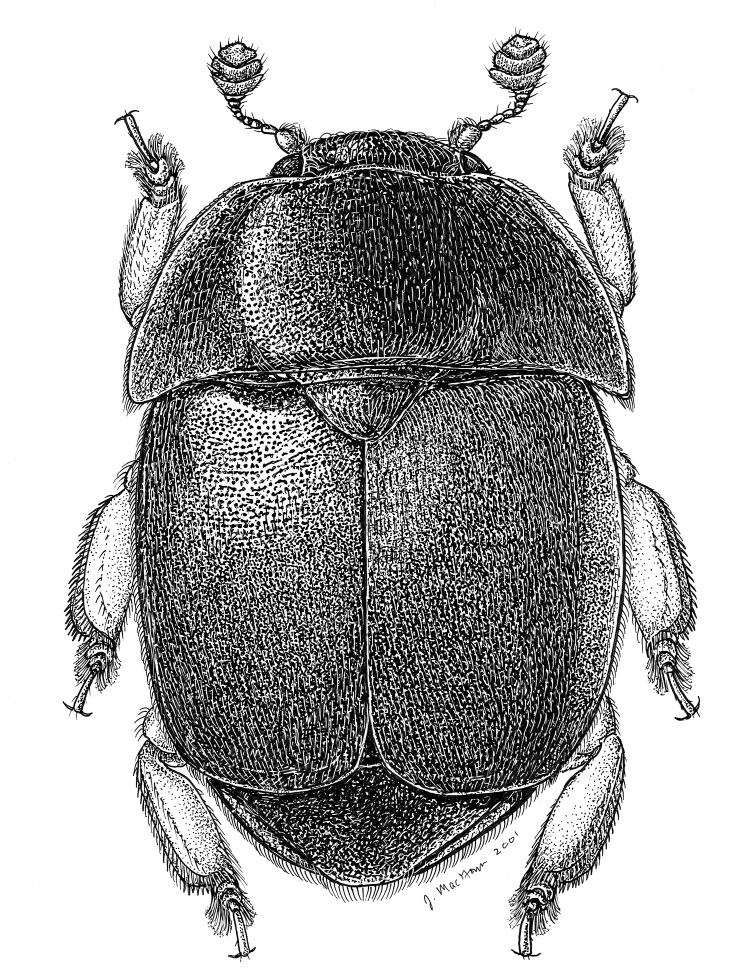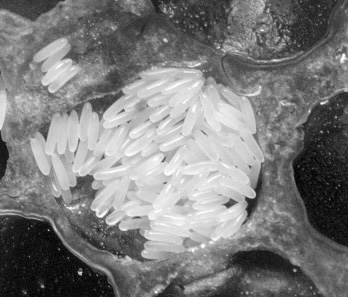Small Hive Beetle
If you have not already seen these little, black beetles scurrying about whenever you lift a hive cover—just wait! They are on their way to an apiary near you, and once these destructive pests invade your hives, they are hard to eliminate. The potential damage to your colonies is great, but before you start fretting over how to protect your bees, you should learn a few facts about these prolific pests. Certainly, small hive beetles create havoc in the honey house or in the mating yard, but once you have an understanding of their life cycle and behavior, you can prevent serious damage to your hives and honey crop through simple management strategies.
Introduction to the United States
The small hive beetle, Aethina tumida Murray, is native to South Africa, where it cohabits naturally with the Cape honey bee, Apis mellifera capensis. While the Cape bee has adapted to hive beetles and can manage the pest well, these beetles can be a major nuisance to other subspecies of honey bees. For example, our Western bees have not acquired the ability to keep them at bay and tend to be overcome by heavy infestations, especially when hives are small or weak.
The first confirmed report of small hive beetle in the United States occurred in 1996 near Charleston, South Carolina. It is believed that beetles were accidentally transported on a cargo ship with a swarm of African honey bees. Once ashore, the beetles spread rapidly among southeastern apiaries because of the favorable climate, hive management, and migratory beekeeping practices. At least one subsequent introduction of small hive beetles occurred in Florida in 1998, and hive beetles are now prevalent throughout that state.
Although small hive beetles prefer subtropical and tropical climates, they are now found in nearly every state except Alaska and in several Canadian provinces. They do not overwinter outside the hive in areas where the ground freezes, but a small number of adult beetles will survive inside the hive, capitalizing on the heat produced by clustering bees. Beetles are reintroduced to northern apiaries every spring via migratory beekeeping and package sales.
Biology
Small hive beetle (SHB) is the newest honey bee pest in North America. There are still huge gaps in our knowledge of its ecology and behavior, but we do have some understanding of its life history.
Small hive beetles belong to the insect family Nitidulidae (sap beetles), which are primarily scavengers of rotting fruit, pollen, and fungi. Some nitidulid beetles are myrmecophiles—“ant lovers”—living directly in ant colonies and soliciting food from their host, but the small hive beetle is the only known nitidulid to live exclusively with honey bees. Unlike their myrmecophile relatives, small hive beetles destroy the habitat of their host by feeding on food stores and bee brood, often causing honey bees to flee.

The adults are small (approximately 3–6 millimeters long), oval, reddish-brown to nearly black, and moderately convex when viewed from the side. When they are active, their distinctively clubbed antennae can be clearly seen (Figure 1); when at rest, hive beetles tend to tuck in their head, antennae, and legs, assuming a turtle-like posture. Males and females look virtually identical to the untrained eye, but males tend to be more frequent in the hive supers and females in the brood chamber. Females oviposit clusters of eggs in tiny cracks and crevices (smaller than 1 millimeter) throughout the hive and in the brood combs. In the latter case, a female will hide her egg mass in capped brood cells by entering an adjacent empty cell and chewing a hole through the shared wall. She then will insert her ovipositor and lay a mass of eggs (typically 5–10) next to or beneath the pupating bee. If the eggs are not removed by hygienic bees, they will hatch in 24–48 hours and the beetle larvae will immediately begin feeding on the bee pupa. Females can also pierce the cell caps or oviposit in pollen cells (Figure 2).

Eggs are similar in shape and color to honey bee eggs, but they are smaller. They are rarely noticed during hive inspections and are therefore not used to diagnose an infestation of hive beetles.
Larvae undergo four instars—or growth stages—over a period of about a week. A mature SHB larva is considerably smaller than a full-grown wax moth larva (Figure 3), and SHB larvae never produce webbing. A good rule of thumb for distinguishing between wax moths and SHB larvae is, “if you can easily squish it between thumb and forefinger, it’s a wax moth; if not, it’s a hive beetle.” Wax moths and SHB can infest the same hive at once, so be certain you know the difference between these pests.

| Developmental stage | Duration* |
|---|---|
| Egg | 24-48 hours |
| Feeding larva (L1-L3) | 4-5 days |
| Wandering larva (late L3) | 1-2 days |
| Pupa | 21 days |
| Adult | 6-18 months |
*Averages under optimum conditions. Actual development time varies with temperature and humidity.
Damage
The larva is the detrimental stage of the small hive beetle, and since larval outbreaks consist of hundreds to thousands of individuals, the injury to a hive can be quite significant. They will devour honey, brood, and “bee bread”—basically everything but wax (leave that for the wax moths!), and a large outbreak can consume an entire hive in just a few days. Furthermore, honey supers that have been exposed to hive beetle larvae are unfit for harvest due to contamination. The larvae contain a specific yeast in their guts, Kodamea ohmeri, which is excreted in the feces during feeding. The yeast rapidly ferments honey and pollen, creating a slimy, malodorous mess that is repulsive to honey bees but attractive to adult beetles. The volatile odors produced by the yeast fermentation draw other adult hive beetles from nearby hives and newly emerged beetles from the soil around the apiary. An outbreak of hive beetle larvae, especially in the honey supers, is referred to as a “slimeout” (Figure 4); it almost always coincides with the collapse of the honey bee colony. The presence of larvae in the brood nest or in honey supers is an indication of a high infestation of small hive beetles or a weak colony, so if you see even a few larvae it is imperative that you take a closer look at your bees.

Control
Chemical Methods
Most small-scale beekeepers prefer to use some sort of “trap and kill” method to control adult hive beetles. While very effective at reducing the number of adult beetles in a hive, this tactic is not practical for commercial beekeepers, who usually resort to chemical insecticides. There is currently only one preformulated insecticide registered for in-hive use against hive beetle larvae: the organophosphate miticide, coumaphos, which is sold as Checkmite+ strips. The recommendation for hive beetle control is to cut a strip in half lengthwise (remember to wear gloves!) and staple each piece to the center of the “bumpy” side of a 6-inch square of corrugated plastic or cardboard. Then place the corrugated material strip-down on a solid bottom board. It is best to staple the trap to the bottom board so bees cannot drag it out of the hive. There is a lot of controversy over this control strategy because coumaphos absorbs readily into comb wax and accumulates in the hive over time, potentially poisoning adult bees and brood. If you insist on using coumaphos for SHB control, it is recommended that you replace your old comb with new foundation every 3 years to minimize chemical buildup in the hive. A permethrin-based liquid product like GardStar 40 or Permethrin SFR can be applied to the soil around slimed-out hives to kill wandering larvae and pupae, but this treatment should never be used preventively.
Nonchemical Methods
The recommended strategy for preventing small hive beetle larval outbreaks consists of a combination of good bee management and trapping adult beetles during peak reproductive seasons (April through September in Mississippi). Many small hive beetle traps are commercially available, and many beekeepers make their own. Popular trap designs include a modified screened bottom board with a sliding tray that contains a killing agent; entrance traps; reservoir traps that are placed between frames inside the hive; and top traps that are placed beneath the outer hive cover. Killing agents are food-grade materials that have mechanical insecticidal properties, such as vegetable or mineral oil, diatomaceous earth, soapy water, and propylene glycol. You can read more about recommended hive beetle trapping techniques, as well as download a guide to small hive beetle management in Mississippi at www.extension.org/bee_health.
Honey House Sanitation
The Do Nots of SHB Management
- Do not feed protein supplements or pollen patties in greater amounts than bees can consume in 2 days. Try to restrict pollen feeding to early spring, before SHB colony levels are high.
- Do not leave combs of honey and pollen lying unprotected in the bee yard or the honey house.
- Do not allow colonies to remain queenless for more than a few days. Stressed colonies attract beetles, and queenless colonies cannot defend against heavy SHB infestations.
- Do not leave hives open any longer than necessary during inspection or manipulation.
- Do not place hives in deep shade. Full sunshine is ideal.
- Do not leave dead-outs in the apiary.
- Do not remove more honey than you can extract within 48 hours.
- Do not add drawn combs to hives that do not contain enough bees to cover the combs.
- Do not feed excessive amounts of sugar syrup. SHB also love syrup, especially when it becomes fermented!
The Mississippi State University Extension Service is working to ensure all web content is accessible to all users. If you need assistance accessing any of our content, please email the webteam or call 662-325-2262.



